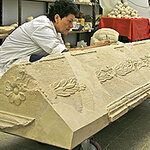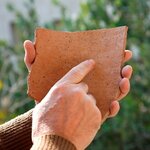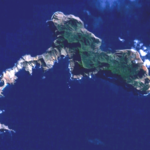Archaeology

In spring 2004, at the meeting of the Scientific Council of the Frombork-based Baltic Research Centre, Jerzy Gąssowski received an interesting challenge - find the remains of Nicolas Copernicus.
To be sure, something was known of his death. He had died in Poland at age 70, and he was buried at his church somewhere, but he died while his work was being printed so the man who theorized that the sun, rather than the Earth, is at the center of the universe, was not yet famous enough to merit a monument. But the provost of the Frombork metropolitan church, bishop Doctor…

Analysis of newly revealed items found at the site of what is believed to be the mausoleum of King Herod at Herodium (Herodion in Greek) have provided Hebrew University of Jerusalem archaeological researchers with more evidence affirming that this was indeed the site of the famed ruler's 1st century B.C.E. grave.
Herod was the Roman-appointed king of Judea from 37 to 4 B.C.E., who was renowned for his many monumental building projects, including the reconstruction of the Temple in Jerusalem, the palace at Masada, the harbor and city of Caesarea, as well as the palatial complex at Herodium, 15…

The new discovery of a 2 million year old female pelvis is changing theories about how smart our ancestors really were. The analysis of the Homo erectus pelvis structure (found in Gona, Ethiopia) indicates an increased possibility of neonatal brain size as well as locomotive ability for homeostasis, two opposing aspects in birth that never previously known for that time.
Skeletal remnants below the skull are hard to come by, and therefore scientists have had a tough time conjuring an accurate representation of ancient Homo erectus physiology. A few skeletons have been helpful with these…

Archaeologists have made a discovery in Egypt, which fills in a missing piece of history in the Old Kingdom ancient burial ground of Saqqara. The newest discovery, found in the sand south of Cairo about two months ago, most likely housed the remains of Queen Shesheshet. Shesheshet, the mother of King Teti, ruled from 2323 BC to 2291 BC and founded Egypt's Sixth Dynasty -- over 4,000 years ago.
Egypt's antiquities chief, Zahi Hawass, identified the significance of the pyramid through the process of elimination. "The only queen whose pyramid is missing is Shesheshet, which is…

Two Durham University scientists are playing a key part in a 3,000 mile trip following the migration route of ancient Pacific cultures. Drs Keith Dobney and Greger Larson, both from the Department of Archaeology, are taking part in the voyage, which will be the first ever expedition to sail in two traditional Polynesian boats - ethnic double canoes - which attempts to re-trace the genuine migration route of the ancient Austronesians.
The main aim of the voyage is to find out where the ancestors of Polynesian culture originated but the Durham University researchers will also be…

The earliest known Hebrew text written in a Proto-Canaanite script has been discovered by Hebrew University archaeologists in an ancient city in the area where David slew Goliath – the earliest Judean city found to date. The 3,000 year old finding is thought to be the most significant archaeological discovery in Israel since the Dead Sea Scrolls – predating them by 1,000 years.
The ostracon (pottery shard inscribed with writing in ink) comprises five lines of text divided by black lines and measures 15 x 15 cm. and was found at excavations of a 10th century B.C.E. fortress - the oldest…

The skeleton of a 12,000 year-old Natufian Shaman has been discovered in northern Israel by archaeologists at the Hebrew University of Jerusalem. The burial is described as being accompanied by "exceptional" grave offerings - including 50 complete tortoise shells, the pelvis of a leopard and a human foot. The shaman burial is thought to be one of the earliest known from the archaeological record and the only shaman grave in the whole region.
Dr. Leore Grosman of the Institute of Archaeology at the Hebrew University, who is heading the excavation at the Natufian site of Hilazon Tachtit in the…

Cast away on a desert island, surviving on what nature alone can provide, praying for rescue but fearing the sight of a boat on the horizon. Just the imaginative creations of Daniel Defoe in his famous novel "Robinson Crusoe?" There has long been a theory that it was based on the real-life experience of sailor Alexander Selkirk, marooned in 1704 on a small tropical island in the Pacific for more than four years, and now archaeological evidence has been found to support contemporary records of his existence on the island.
An article in the journal Post-Medieval Archaeology…

Did the Bible's King David and his son Solomon control the copper industry in present-day southern Jordan? The possibility is raised once again by research reported in the Proceedings of the National Academy of Sciences.
Led by Thomas Levy of UC San Diego and Mohammad Najjar of Jordan's Friends of Archaeology, an international team of archaeologists has excavated an ancient copper-production center at Khirbat en-Nahas down to virgin soil, through more than 20 feet of industrial smelting debris, or slag. The 2006 dig has brought up new artifacts and with them a new suite of radiocarbon dates…

Within the scope of an international rescue excavation project, a team of four archaeologists specialized in Middle Eastern affairs headed by Dr. Dirk Wicke (Institute of Egyptology and Ancient Near Eastern Studies) have unearthed parts of a Neo-Assyrian governor's palace dating back to the 9th to 7th cent. B.C. in a two-month excavation program amongst the ruins on Ziyaret Tepe.
The discoveries were extraordinary. The site in the south-east of Turkey (Diyarbakir province) is at risk from the construction of the Ilisu Dam. For several years now it has been investigated by teams from the…